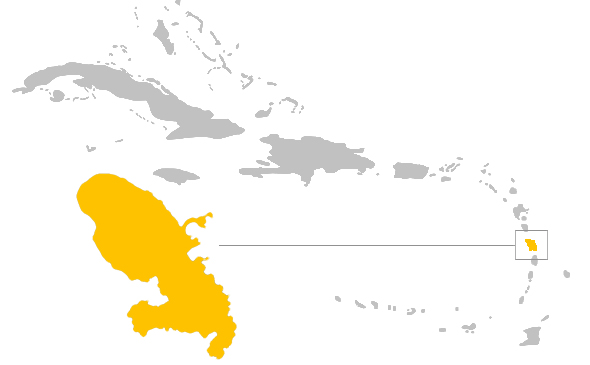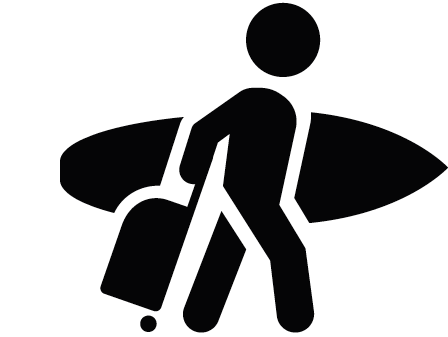Surfing in Martinique

Martinique is a Caribbean island and is part of the Lesser Antilles, or Breezy Islands. The island has 350 km (217 mi) of rugged coastline that creates an opportunity for lots of high quality surf spots. Most of the breaks are located on the north coast that is fully exposed to the consistent Atlantic Ocean whereas the south coast is bathed by the Caribbean Sea that usually lacks swell. The south shore of the island is known for picture perfect beaches and also has numerous but fickle surf spots. Although surf only arrived in the Martinique in the 90s the island has a small but very enthusiastic surf community. Even nowadays you can still see young locals riding waves at Basse Point or Lorrain with logs of wood that were used before real surfboards were brought by foreigners to the island. Martinique is an overseas french territory that reflects the same food and cultural approach of France with west indian influences. You should add Martinique to your bucket list of surf destinations because surfing in this beautiful island allows you to enjoy perfect tropical waves in some of the most amazing and stunning backdrops that you ever seen. As you can see it’s impossible to be bored if you come to surf in Martinique.
Climate in Martinique
The climate in Martinique is tropical with hot and humid weather all year round. There is a cool and dry season from January to mid-April and a hot and rainy season from mid-June to mid-November. During the dry season the northeast trade wind prevails. During the wet season these winds are less constant increasing significantly the heat index.
The best time to surf in Martinique is from November to March with N-NE swells arriving down from the North Atlantic Coast. From July to October is the hurricane season and big swells can arrive but they are often very unpredictable and usually come along with strong offshore winds. The water temperature is warm throughout the whole year.
Best surf spots in Martinique
The most popular surf spot in Martinique is Anse Bonville at the Plage des Surfeurs on the Caravelle Peninsula. At Anse Couleuvre on the northern tip of the Caribbean Coast it's possible to surf some of the best waves on the island: a strong, fast tubular right of up to 3 meters with a shallow reef.
Experienced surfers should try the long waves that break at the entrance of Basse Pointe port flanked by high cliffs. Other surf spots in the island are:
NORTH CARIBBEAN: Tomate, Anse Ceron,Anse Couleuvre
NORTH ATLANTIC: Bagasse, Charlot, Basse Pointe, Anse Charpentier, Caravelle, Anse Bonville
SOUTH MARTINIQUE: Anse Trabaud, Diamant and Anse Cafard
Budget Planning
Meal price range
Simple meals start at $12 USD. Mid-range meals start at $24 USD. Dining & drinking at high-end restaurants can cost anywhere from $50-90 USD
Equipment rental
Surfboards rentals start at $12 USD for 1.5 hours.
Prepaid SIM cards
Orange is a good choice.
SIM cards can be purchased from official stores, approved resellers or at supermarkets.
Prepaid packages start at $12 USD.
Public transport
Most visitors rent a car for their time in Martinique.
A regular vedette (ferry) between Martinique’s main resort areas and Fort-de-France provides a nice alternative to dealing with heavy bus and car traffic.
There are some larger public buses serving Fort-de France and its surrounding areas. Most buses elsewhere in Martinique are minivans marked ‘TC’ (for taxis collectifs) on top.
Taxis are pricey. A 40% surcharge is added to all fares between 8pm and 6am, and all day on Sunday and holidays.
Rental cars start at around $38 a day.
Gas prices
$1.42 USD a liter.
Types of risks
Coral and rocky breaks, hurricanes
How to prepare
Visa
Citizens from the UK and EU can enter visa free and stay an unlimited amount of time. Visitors from the US, Canada and Australia can also enter visa free but only stay up to 3 months.
Vaccines
Although it's not mandatory, it’s recommended that you have been vaccinated for hepatitis A & B, yellow fever, typhoid, rabies, meningitis, polio, Tdap, chickenpox, shingles, pneumonia, influenza, measles, mumps and rubella. You’ll be asked to show proof of your yellow fever vaccination if you come from a country with a risk of yellow fever.
Things to know
Language & Currency
The official language is French. English is not widely spoken.
The currency is the euro (€).
Best time to go
The best season for surfing in Martinique is from November to March with N-NE swells driving down the North Atlantic Coast from North America.
Checking Surf forecast
Checking the forecast about a week before your trip is always a good idea. Understanding what the waves will be like and knowing what gear to pack is essential. You can check the forecast for the waves here.
Do I need pack a pharmacy kit
You should bring a basic kit. Including ear drops, eye drops, bandaids, ear plugs, gaze, alcohol, mosquito repellent and broad spectrum antibiotic ointment.
Travel/Surf Insurance
World Nomads has great travel insurance packages that are not super expensive and they cover surfing.
Emergency
Dial 15
Check surf pictures of Martinique at #martiniquesurfing.

